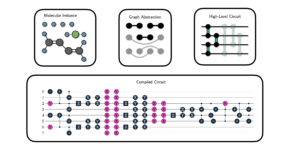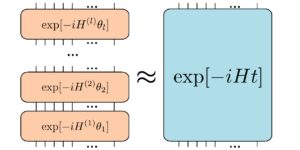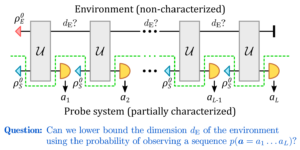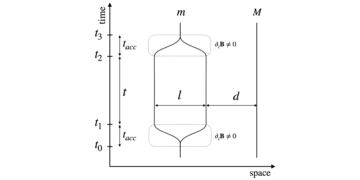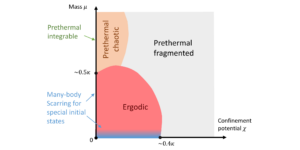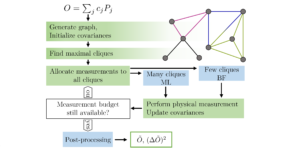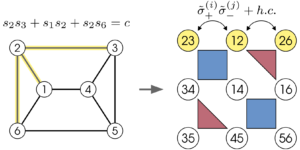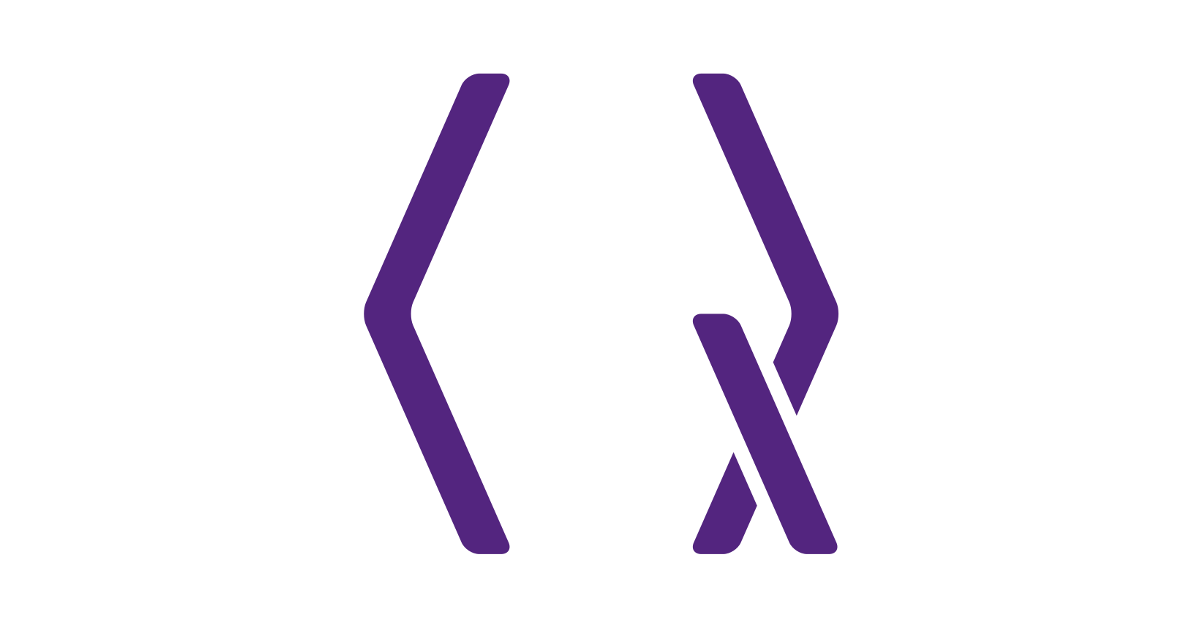
1Institute of Theoretical Physics and IQST, Universität Ulm, Albert-Einstein-Allee 11 D-89081, Ulm, Germany
2QuSoft, Science Park 123, 1098 XG Amsterdam, the Netherlands
3Korteweg–de Vries Institute for Mathematics, University of Amsterdam, Science Park 105-107, 1098 XG Amsterdam, the Netherlands
4Institute for Theoretical Physics, University of Amsterdam, Science Park 904, 1098 XH Amsterdam, the Netherlands
Find this paper interesting or want to discuss? Scite or leave a comment on SciRate.
Abstract
When two particles interact primarily through gravity and follow the laws of quantum mechanics, the generation of entanglement is considered a hallmark of the quantum nature of the gravitational interaction. However, we demonstrate that entanglement dynamics can also occur in the presence of a weak quantum interaction and non-linear corrections to local quantum mechanics, even if the gravitational interaction is classical or absent at short distances. This highlights the importance of going beyond entanglement detection to conclusively test the quantum character of gravity, and it requires a thorough examination of the strength of other quantum forces and potential non-linear corrections to quantum mechanics in the realm of large masses.
Popular summary
► BibTeX data
► References
[1] R.P. Feynman, in Chapter 23 of The role of Gravitation in Physics, Report from the 1957 Chapel Hill Conference.
https://doi.org/10.34663/9783945561294-00
[2] N.H. Lindner and A. Peres, Testing quantum superpositions of the gravitational field with Bose-Einstein condensates, Phys. Rev. A 71, 024101 (2005).
https://doi.org/10.1103/PhysRevA.71.024101
[3] D. Kafri and J.M. Taylor, A noise inequality for classical forces, arXiv:1311.4558.
arXiv:1311.4558
[4] D. Kafri, J.M. Taylor, and G.J. Milburn, A classical channel model for gravitational decoherence, New J. Phys. 16, 065020 (2014).
https://doi.org/10.1088/1367-2630/16/6/065020
[5] T. Krisnanda, M. Zuppardo, M. Paternostro, and T. Paterek, Revealing nonclassicality of inaccessible objects, Phys. Rev. Lett. 119, 120402 (2017).
https://doi.org/10.1103/PhysRevLett.119.120402
[6] C. Marletto and V. Vedral, Gravitationally induced entanglement between two massive particles is sufficient evidence of quantum effects in gravity, Phys. Rev. Lett. 119, 240402 (2017).
https://doi.org/10.1103/PhysRevLett.119.240402
[7] R.J. Marshman, A. Mazumdar, and S. Bose, Locality & entanglement in table-top testing of the quantum nature of linearized gravity, Phys. Rev. A 101, 052110 (2020).
https://doi.org/10.1103/PhysRevA.101.052110
[8] T.D. Galley, F. Giacomini, and J.H. Selby, A no-go theorem on the nature of the gravitational field beyond quantum theory, Quantum 6, 779 (2022).
https://doi.org/10.22331/q-2022-08-17-779
[9] M. Christodoulou, A. Di Biagio, M. Aspelmeyer, C. Brukner, C. Rovelli, and R. Howl, Locally mediated entanglement in linearized Quantum Gravity, Phys. Rev. Lett. 130, 100202 (2023).
https://doi.org/10.1103/PhysRevLett.130.100202
[10] D. Carney, Newton, entanglement, and the graviton, Phys. Rev. D 105, 024029 (2022).
https://doi.org/10.1103/PhysRevD.105.024029
[11] V. Fragkos, M. Kopp, and I. Pikovski, On inference of quantization from gravitationally induced entanglement, AVS Quantum Sci. 4, 045601 (2022).
https://doi.org/10.1116/5.0101334
[12] M.J.W. Hall and M. Reginatto, On two recent proposals for witnessing nonclassical gravity, J. Phys. A 51, 085303 (2018); E. Marconato and C. Marletto, Vindication of entanglement-based witnesses of non-classicality in hybrid systems, arXiv:2102.10615; M.J.W. Hall and M. Reginatto, Comment on `Vindication of entanglement-based witnesses of non-classicality in hybrid systems’, arXiv:2111.05033.
https://doi.org/10.1088/1751-8121/aaa734
arXiv:2111.05033
[13] K. Döner and A. Großardt, Is gravitational entanglement evidence for the quantization of spacetime? Found. Phys. 52, 101 (2022).
https://doi.org/10.1007/s10701-022-00619-0
[14] T.W.B. Kibble, Relativistic models of non-linear quantum mechanics, Commun. Math. Phys. 64, 73 (1978).
https://doi.org/10.1007/BF01940762
[15] T.W.B. Kibble and S. Randjbar-Daemi, Non-linear coupling of quantum theory and classical gravity. J. Phys. A: Math. Gen. 13, 141 (1980).
https://doi.org/10.1088/0305-4470/13/1/015
[16] J.S. Pedernales, G.W. Morley, and M.B. Plenio, Motional dynamical decoupling for matter-wave interferometry, Phys. Rev. Lett. 125, 023602 (2020); J.S. Pedernales, G.W. Morley, and M.B. Plenio, arXiv:1906.00835.
https://doi.org/10.1103/PhysRevLett.125.023602
arXiv:1906.00835
[17] S. Weinberg, Precision tests of quantum mechanics, Phys. Rev. Lett. 62, 485 (1989).
https://doi.org/10.1103/PhysRevLett.62.485
[18] S. Weinberg, Testing quantum mechanics, Ann. Phys. 194, 336 (1989).
https://doi.org/10.1016/0003-4916(89)90276-5
[19] N. Gisin, Weinberg’s non-linear quantum mechanics and superluminal communications, Phys. Lett. A 143, 1 (1989).
https://doi.org/10.1016/0375-9601(90)90786-N
[20] M. Czachor, Mobility and non-separability, Found. Phys. Lett. 4, 351 (1991).
https://doi.org/10.1007/BF00665894
[21] J. Polchinski, Weinberg’s non-linear quantum mechanics and the Einstein-Podolpsky-Rosen paradox, Phys. Rev. Lett. 66, 397 (1991).
https://doi.org/10.1103/PhysRevLett.66.397
[22] A. Kent, Non-linearity without superluminality, Phys. Rev. A 72, 012108 (2005).
https://doi.org/10.1103/PhysRevA.72.012108
[23] J.J. Bollinger, D.J. Heinzen, W.M. Itano, S.L. Gilbert, and D.J. Wineland, Test of the linearity of quantum mechanics by rf spectroscopy of the ${}^9$Be${}^+$ ground state, Phys. Rev. Lett. 63, 1031 (1989).
https://doi.org/10.1103/PhysRevLett.63.1031
[24] J. Schmöle, M. Dragosits, H. Hepach, and M. Aspelmeyer, A micromechanical proof-of-principle experiment for measuring the gravitational force of milligram masses, Classical Quant. Grav. 33, 125031 (2016).
https://doi.org/10.1088/0264-9381/33/12/125031
[25] S. Bose, A. Mazumdar, G.W. Morley, H. Ulbricht, M. Toros, M. Paternostro, A.A. Geraci, P.F. Barker, M.S. Kim, and G. Milburn, Spin entanglement witness for quantum gravity, Phys. Rev. Lett. 119, 240401 (2017).
https://doi.org/10.1103/PhysRevLett.119.240401
[26] D. Carney, H. Müller, and J.M. Taylor, Testing quantum gravity with interactive information sensing, PRX Quantum 2, 030330 (2021).
https://doi.org/10.1103/PRXQuantum.2.030330
[27] K. Streltsov, J.S. Pedernales, and M.B. Plenio, On the significance of interferometric revivals for the fundamental description of gravity, Universe 8, 58 (2022).
https://doi.org/10.3390/universe8020058
[28] J.S. Pedernales, K. Streltsov, and M.B. Plenio, Enhancing gravitational interaction between quantum systems by a massive mediator, Phys. Rev. Lett. 128, 110401 (2022).
https://doi.org/10.1103/PhysRevLett.128.110401
[29] T. Krisnanda, G.Y. Tham, M. Paternostro, and T. Paterek, Observable quantum entanglement due to gravity, npj Quant. Inf. 6, 12 (2020).
https://doi.org/10.1038/s41534-020-0243-y
[30] F. Cosco, J.S. Pedernales, and M.B. Plenio, Enhanced force sensitivity and entanglement in periodically driven optomechanics, Phys. Rev. A 103, L061501 (2021).
https://doi.org/10.1103/PhysRevA.103.L061501
[31] T. Weiss, M. Roda-Llordes, E. Torrontegui, M. Aspelmeyer, and O. Romero-Isart, Large quantum delocalization of a levitated nanoparticle using optimal control: applications for force sensing and entangling via weak forces, Phys. Rev. Lett. 127, 023601 (2021).
https://doi.org/10.1103/PhysRevLett.127.023601
[32] C.H. Bennett, H.J. Bernstein, S. Popescu, and B. Schumacher. Concentrating partial entanglement by local operations, Phys. Rev. A 53, 2046 (1996).
https://doi.org/10.1103/PhysRevA.53.2046
[33] M.B. Plenio and S. Virmani, Quant. Inf. Comp. 7, 1 (2007).
https://doi.org/10.1007/978-3-319-04063-9_8
[34] H.B.G. Casimir and D. Polder. The Influence of Retardation on the London-van der Waals Forces, Phys. Rev. 73, 360 (1948).
https://doi.org/10.1103/PhysRev.73.360
[35] W.M. Zhang and R. Gilmore, Coherent states: theory and some applications, Rev. Mod. Phys. 62, 4 (1990).
https://doi.org/10.1103/RevModPhys.62.867
[36] F. Casas, A. Murua and M. Nadinic, Efficient computation of the Zassenhaus formula, Comput. Phys. Commun. 183, 11 (2012).
https://doi.org/10.1016/j.cpc.2012.06.006
[37] J. Oppenheim, C. Sparaciari, B. Soda, and Z. Weller-Davies, Gravitationally induced decoherence vs space-time diffusion: testing the quantum nature of gravity, Quantum 7, 891 (2023).
https://doi.org/10.22331/q-2023-01-03-891
[38] N. Brunner, D. Cavalcanti, S. Pironio, V. Scarani, and S. Wehner, Bell nonlocality, Rev. Mod. Phys. 86, 419 (2014).
https://doi.org/10.1103/RevModPhys.86.419
[39] D. Calvani, A. Cuccoli, N.I. Gidopoulos and P. Verrucchi, Parametric representation of open quantum systems and cross-over from quantum to classical environment, Proc. Nat. Acad. Sci. 110, 6748 (2013).
https://doi.org/10.1073/pnas.1217776110
[40] G. Spaventa and P. Verrucchi, Nature and origin of operators entering the master equation of an open quantum system, Open Syst. Inf. Dyn. 29(02), 2250010 (2022).
https://doi.org/10.1142/S123016122250010X
[41] L.G. Yaffe, Large N limits as classical mechanics, Rev. Mod. Phys. 54, 407 (1982).
https://doi.org/10.1103/RevModPhys.54.407
[42] J. Rembieliński and P. Caban Nonlinear evolution and signaling, Phys. Rev. Research 2, 012027 (2020).
https://doi.org/10.1103/PhysRevResearch.2.012027
Cited by
[1] Ludovico Lami, Julen S. Pedernales, and Martin B. Plenio, “Testing the quantum nature of gravity without entanglement”, arXiv:2302.03075, (2023).
The above citations are from SAO/NASA ADS (last updated successfully 2023-10-25 15:08:50). The list may be incomplete as not all publishers provide suitable and complete citation data.
Could not fetch Crossref cited-by data during last attempt 2023-10-25 15:08:49: Could not fetch cited-by data for 10.22331/q-2023-10-25-1157 from Crossref. This is normal if the DOI was registered recently.
This Paper is published in Quantum under the Creative Commons Attribution 4.0 International (CC BY 4.0) license. Copyright remains with the original copyright holders such as the authors or their institutions.
- SEO Powered Content & PR Distribution. Get Amplified Today.
- PlatoData.Network Vertical Generative Ai. Empower Yourself. Access Here.
- PlatoAiStream. Web3 Intelligence. Knowledge Amplified. Access Here.
- PlatoESG. Carbon, CleanTech, Energy, Environment, Solar, Waste Management. Access Here.
- PlatoHealth. Biotech and Clinical Trials Intelligence. Access Here.
- Source: https://quantum-journal.org/papers/q-2023-10-25-1157/
- :is
- :not
- :where
- ][p
- 06
- 08
- 1
- 10
- 11
- 12
- 125
- 13
- 14
- 15%
- 16
- 17
- 19
- 1996
- 20
- 2005
- 2012
- 2013
- 2014
- 2016
- 2017
- 2018
- 2020
- 2021
- 2022
- 2023
- 22
- 23
- 24
- 25
- 26%
- 27
- 28
- 29
- 30
- 31
- 32
- 33
- 35%
- 36
- 39
- 40
- 41
- 49
- 50
- 51
- 54
- 58
- 66
- 7
- 72
- 8
- 9
- a
- above
- absent
- ABSTRACT
- access
- affiliations
- All
- also
- amsterdam
- an
- and
- answer
- applications
- ARE
- AS
- assumption
- At
- attempt
- author
- authors
- BE
- Bell
- Bernstein
- between
- Beyond
- Break
- by
- CAN
- Can Get
- Certified
- Channel
- Chapter
- character
- closed
- COHERENT
- comment
- Commons
- Communications
- COMP
- complete
- computation
- Conference
- considered
- control
- copyright
- Corrections
- could
- data
- demonstrate
- description
- Detection
- Diffusion
- discuss
- driven
- due
- during
- dynamics
- e
- effects
- efficient
- enhanced
- enhancing
- entanglement
- entering
- Environment
- Even
- evidence
- evolution
- expects
- experiment
- experiments
- fact
- field
- follow
- For
- Force
- Forces
- formula
- found
- from
- fundamental
- fundamentally
- Gen
- generation
- get
- gilbert
- going
- gravitational
- gravity
- Ground
- Hall
- harvard
- Hidden
- highlights
- holders
- How
- However
- HTTPS
- Hybrid
- i
- if
- importance
- in
- inaccessible
- inequality
- influence
- information
- Institute
- institutions
- interact
- interaction
- interactions
- interactive
- interesting
- International
- IT
- JavaScript
- journal
- Kim
- Kind
- large
- Last
- Laws
- Leave
- License
- limits
- List
- local
- locally
- loophole
- Martin
- masses
- massive
- master
- math
- mathematics
- Matters
- May..
- measuring
- mechanics
- mobility
- model
- models
- Month
- Nature
- New
- Newton
- no
- Noise
- normal
- objects
- Oct
- of
- on
- ONE
- open
- opening
- Operations
- operators
- optimal
- or
- origin
- original
- Other
- pages
- Paper
- Paradox
- Park
- Physics
- plato
- Plato Data Intelligence
- PlatoData
- potential
- Precision
- presence
- primarily
- PROC
- Proposals
- provide
- published
- publisher
- publishers
- Quant
- Quantum
- quantum entanglement
- Quantum Mechanics
- quantum systems
- question
- R
- realm
- recent
- recently
- references
- registered
- remains
- report
- representation
- requires
- research
- result
- revealing
- Role
- s
- same
- scales
- SCI
- Science
- see
- Sensitivity
- Short
- show
- significance
- So
- some
- Spectroscopy
- Spin
- State
- States
- strength
- Successfully
- such
- sufficient
- suitable
- system
- Systems
- taken
- test
- Testing
- tests
- that
- The
- their
- then
- theoretical
- theory
- These
- this
- Through
- Title
- to
- traded
- try
- two
- under
- Universe
- university
- updated
- URL
- using
- via
- volume
- vs
- W
- want
- was
- Way..
- we
- weiss
- whether
- which
- with
- without
- witness
- witnessing
- Work
- year
- zephyrnet


